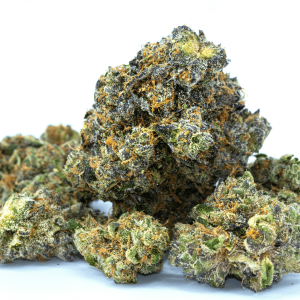Today, we’re diving headfirst into the exciting and aroma-filled world of the fantastic humulene terpene! Alpha-humulene, the unsung hero of the terpene family, can be found in hops (yes, the beer kind), coriander, cloves, and basil.
Its delightful aroma will have your nose doing a happy dance. But hold on, it’s not just a pretty smell! Humulene also boasts some impressive potential benefits. So grab a joint (with extra humulene content, of course), and let’s get started!
The Science of Terpenes: A Quick Refresher
Before we dive deeper into humulene, let’s take a moment to talk about terpenes.
In case you need a refresher, terpenes are like the essential oils of cannabis. They’re the aromatic compounds that give our favorite plant its distinct aroma and flavor.
Have you ever wondered why some strains smell like a citrus grove, while others are reminiscent of a pine forest or a field of lavender? You are getting a whiff of terpenes!
But they’re not just there to please your olfactory senses. Terpenes also play a crucial role in influencing the overall effects of cannabis, working in tandem with cannabinoids like THC and CBD to create a unique vibe for every strain.
Now that we’re all on the same page, let’s dive back into humulene!
What is Humulene? An Intriguing Introduction
Humulene, also known as α-humulene or alpha-humulene, is an organic compound and a prevalent cannabis terpene.
This terpene is responsible for the pleasantly earthy, woody, and spicy aroma you find in many of your favorite cannabis strains. But humulene isn’t restricted to cannabis strains alone! It’s widely present in nature, specifically found in the essential oils of plants like sage, ginger, ginseng, and, as we mentioned before, the hops plant (think your favorite craft beer!).
But humulene is so much more than an aromatic compound. It’s a functional fragrance, harboring potential health benefits that have drawn the attention of scientists and stoners alike. In fact, it has been associated with potential anti-inflammatory, antibacterial, and appetite-suppressant properties.

What’s in a Name: Humulene
You might be wondering, where did Humulene get its name? Well, the word ‘humulene’ derives from ‘Humulus Lupulus,’ the Latin name for hops. So, it’s named after one of the first plants in which it was discovered.
Humulene: Where to Find It
Alpha-Humulene isn’t a rare, elusive compound, but rather a fairly common occurrence in nature and many cannabis strains.
It’s present in numerous plants and herbs, infusing them with its characteristic earthy aroma and potential health benefits.
Here are some notable sources where you can find humulene:
- Cannabis: The cannabis plant is one of the most abundant sources of humulene. It contributes to the plant’s distinctive aroma and various therapeutic properties.
- Hops: The flavoring agent in your favorite beer, otherwise known as hops, is rich in humulene. It’s responsible for the bitter, tangy taste and aromatic experience.
- Sage: This aromatic herb, commonly used in cooking and traditional medicine, is another source of humulene.
- Ginger: Among numerous health benefits, ginger is also known for containing humulene terpene.
- Ginseng: This traditional medicinal root is packed with humulene, contributing to its therapeutic potential.
- Coriander: Your favorite spice isn’t just about taste; it’s also a source of this wonderful terpene.
- Cloves: This aromatic flower bud is another place where humulene naturally occurs.

The Nitty-Gritty: Humulene’s Chemical Structure
It’s time to put on those lab coats and safety goggles because we’re diving into the fascinating topic of molecular structures! But don’t worry, we promise to keep it light-hearted. After all, we’re here for a good time, not to relive those high school chemistry classes.
Humulene terpene is an organic compound, a member of the sesquiterpene class. But what on earth is a sesquiterpene, you ask? Well, in less jargon-filled terms, it’s simply a term for a class of terpenes that have three isoprene units and fifteen carbon atoms.
If we could see Humulene under a microscope (and let’s pretend for a moment we can), imagine it looking like a delicate piece of molecular origami. It’s a cyclic molecule, which means it forms a closed loop. Its chemical formula is C15H24 and it shares the same molecular formula with its cousin, Caryophyllene. The only difference? The arrangement of atoms and the bonds between them.
Not Just a Pretty Smell: The Benefits of Humulene
Humulene isn’t just a fest for your olfactory senses, but it also brings to the table a slew of potential benefits that’ll have your mind blown. So roll that joint, sit back, and keep reading for a list of Humulene’s potential therapeutic benefits:
- Anti-inflammatory Powerhouse: Humulene has potential anti-inflammatory properties. It could be beneficial for soothing the body after a strenuous workout or a long session of binge-watching.
- Appetite Suppressant: You know those insatiable munchies that kick in after a good sesh? Well, humulene might actually help keep those at bay. With Humulene, you can enjoy your high without the fear of devouring your entire pantry!
- Antibacterial Properties: It’s well known that we’re currently in a time where antibacterial properties are highly valued. Interestingly, humulene may also possess some antibacterial magic.
- Anticancer Potential: While it’s not a sure-shot cure, there’s ongoing research to explore humulene’s potential as an anticancer agent, inhibiting tumor growth and killing cancer cells.
- Pain Relief: Last but not least, humulene might just be the holistic pain reliever you’ve been seeking. So the next time you find yourself reaching for a hot water bottle or painkillers, remember, Mother Nature might have already rolled you a natural solution.
Remember, more research is needed to fully understand the extent of these potential benefits. So, while we puff and pass, let’s also press for more cannabis studies.
The Future of Humulene: Research and Developments
The world of science never sleeps, and when it comes to humulene, the excitement is buzzing.
Imagine a future where simply lighting up a joint could potentially act as an appetite suppressant, an anti-inflammatory, or even as a means of pain relief. That’s what researchers around the globe are working tirelessly to uncover. The world of humulene is ripe with potential, and scientists are diving headfirst into its exploration.
Current research is focusing on how to maximize humulene’s potential benefits and minimize any side effects. There are even some promising investigations into its potential anticancer properties.
But remember, science is a marathon, not a sprint. While we’re eager to reap all the potential benefits of humulene, patience is key. More studies are needed, more tests need to be run, and more data needs to be analyzed. But the future looks bright.
Conclusion: The Final Word on Humulene
And that wraps up our whirlwind romance with Humulene, the terpene that’s been under our noses (quite literally) all along, and yet most of us didn’t have a clue about its existence.
Humulene is like the Jack of all trades in the terpene world, popping up everywhere from our beloved cannabis collection to our Friday night beer.
But the best part? It’s a potential munchie-buster, helping us avoid those post-sesh raids on the pantry. And with potential anti-inflammatory, antibacterial, and pain-relieving properties, Humulene appears to be like your own private superhero, fighting off villains in your body.
As we eagerly await more research, let’s raise a joint (or a glass of hoppy beer) to Humulene, the unassuming yet multi-talented terpene that has us all fascinated.

Frequently Asked Questions
1. What strain has the highest humulene?
The strain “White Walker Kush” is known for its high level of humulene, followed closely by “Headband” and “Pink Kush.” However, the humulene content can vary depending on the growing conditions and processing methods of the plant.
2. Does humulene make you sleepy?
No, humulene does not necessarily induce sleepiness. However, it is often found in indica-dominant cannabis strains that are also rich in myrcene, a terpene known to have sedative effects. So, while humulene itself might not make you sleepy, the strain you’re consuming could be due to the presence of other terpenes and cannabinoids.
3. What does humulene feel like?
Humulene is known for its subtle earthy, woody aroma with spicy undertones. It doesn’t produce a specific feeling per se, but it can contribute to the overall entourage effect of a cannabis strain, potentially enhancing feelings of relaxation or euphoria.
4. Does humulene increase appetite?
Actually, it’s the opposite. Unlike certain other terpenes found in cannabis, humulene is believed to act as an appetite suppressant. This makes it potentially useful for those seeking to control their appetite or lose weight.

 Rewards
Rewards




